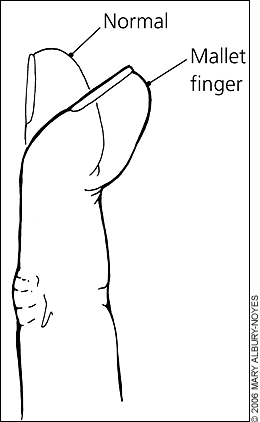
Am Fam Physician. 2006;73(5):823
See related article on acute finger injuries.
What is mallet finger?
Mallet finger is an injury to your fingertip that usually happens when a ball hits the end of your finger while playing sports (see drawing).

How can I tell if I have mallet finger?
Your finger may hurt or you may have trouble straightening the tip of your finger.
When should I go to the doctor?
If your finger hurts or if you think you have injured it, you should see a doctor right away. If you wait too long to get treatment, you may always have problems with your finger. It could also become deformed.
How can my doctor tell if I have mallet finger?
Your doctor will ask you questions and look at your finger to tell for sure if it is injured. You may need an x-ray to make sure you don’t have a broken bone.
How is mallet finger treated?
If your finger hurts or is swollen, your doctor may tell you to put an ice pack on it. If your finger doesn’t move normally, your doctor will put a splint on your finger to keep it in place while it heals. It is important that you do not move your finger until it is completely healed. You will probably need someone to help you change your splint or have your doctor do it for you. You may need to see a subspecialist if a bone is broken or if your finger isn’t healing right.
When can I play sports again?
Most people can still play sports with a finger in a splint. Some sports are hard to play with a splint. Your doctor can tell you for sure when it is safe to play sports again without a splint.